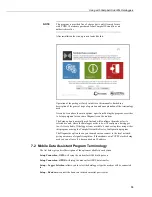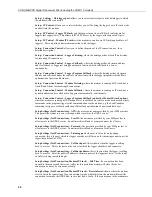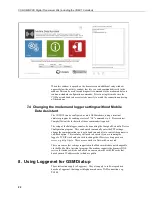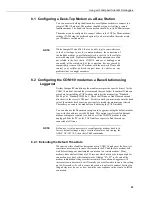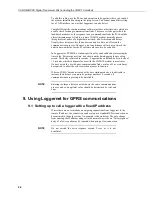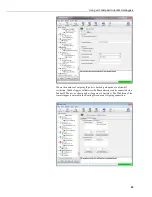
CS-GSM/GPRS Digital Transceiver Kits (including the COM110 modem)
To achieve lower power states either a power switch can be used in the power line,
(see the installation section below), or if using a datalogger that is running its own
TCP/IP stack, you can close the PPP connection (using PPPClose in your
program), which will put the modem in a lower power state. Once in this state the
modem can still accept incoming GSM dial-up calls.
The lowest power use is achieved by cutting power to the modem. When doing
this it is important to deregister the modem from the network before turning off
the power. This is usually done by sending a command AT+CFUN=0 to the
modem and waiting at least 2 seconds before turning off the power. Failure to do
this may result in subsequent connections to the network being refused for
prolonged periods or the modem even being barred from the network if this is
done frequently. When powering up the modem again and then using PPPOpen to
restart the GPRS connection, it is advisable to add delays (of 10s or so) in the
program for the modem to register on the network and the PPP session to start
before starting to send out any data.
By implication the logger defaults to the PPPOpen state as soon as a
port is activated for PPP. This is not dependent on a program
running. To stop a PPP connection being made when a program is
recompiled, include a PPPClose instruction after the BEGIN
instruction. Do this with consideration because if you load a
program that incorrectly calls PPPClose you could block further
communications. .
If using the Modem IP stack, there are less options for shutting down the GPRS
link. Normally the only option is by cutting the power to the modem. If this is
done, avoid doing this too frequently as it is not possible to cleanly log off from
the network, which can lead to delays in registering the modem when power is
restored.
In either mode of operation you can use the “call-back” function of Loggernet (see
above) to make a special call back to the logger (using the Sendvariables
command) which in turn triggers a normal data collection from the logger. When
using the logger IP stack the GPRS connection and power can be controlled to
enable them only during the call-back. When using the modem IP Stack, it can be
configured to minimise use of the connection when set up for “Program controlled
call-back”.
5.5 Calling the logger in GSM dial-up mode when it is set for GPRS comms
In some circumstances it may be advantageous to call out to the system in GSM
dialup mode by dialling and connecting with a phone modem. This may be
necessary in the event of failure of the GPRS network or network connections that
prevent dial-back to the Loggernet server. It is possible to call the logger in the
standard way (see above) providing you know the GSM data phone number and
also providing the logger has periods of operation when the PPP connection is not
enabled, i.e. PPPClose has been called.
It is not possible to establish a GSM data connection whilst a PPP
session is in progress. It is not possible to call a COM110 in GSM
mode when it is configured for GPRS use.
5.6 Sending configuration commands to the modem
It is often advisable to reset the modem at regular intervals or send other
configuration commands to the modem, for instance to enable very low power
states between calls. When using the loggers IP Stack, this can be done within the
NOTE
NOTE
12






















